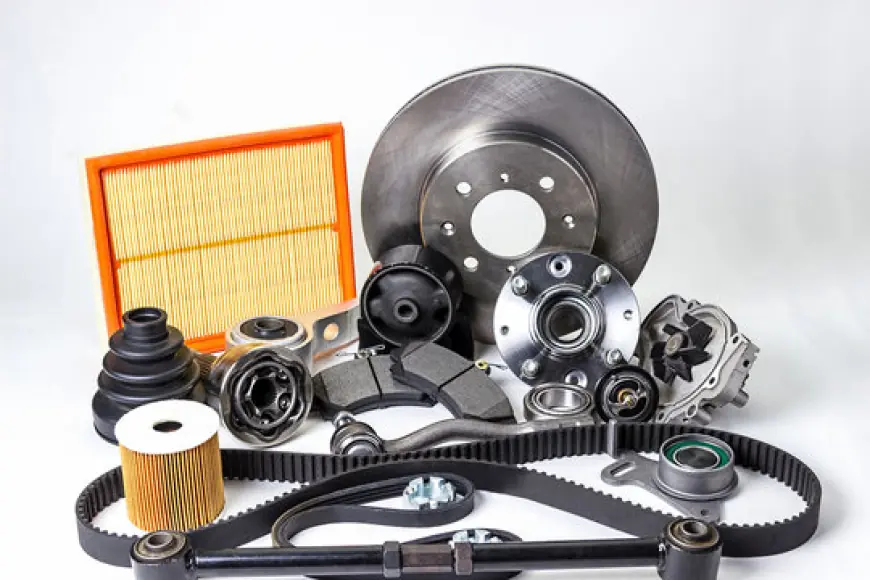Global Automotive Brake Components Aftermarket 2030F Market Scope
Challenges in the aftermarket include the presence of counterfeit or substandard products, emphasizing the importance of quality assurance and consumer education.

According to TechSci Research report, “Automotive Brake Components Aftermarket – Global Industry Size, Share, Trends, Competition Forecast & Opportunities, 2029”, the Global Automotive Brake Components Aftermarket stood at USD 33.74 Billion in 2023 and is anticipated to grow at a CAGR of 6.64% through 2029.
The automotive brake components aftermarket has become one of the most dynamic and strategically important sectors in the global automotive industry. Encompassing a broad spectrum of products and services, it plays a critical role in ensuring the safety, efficiency, and longevity of vehicles. As braking systems are the cornerstone of vehicle control and accident prevention, the aftermarket ensures that cars, trucks, and buses on the road remain safe and reliable throughout their lifecycle.
With the rapid expansion of the global automotive fleet and heightened emphasis on road safety, the demand for aftermarket brake components continues to grow steadily. In addition, technological advancements, regulatory initiatives, and consumer preferences are reshaping the sector and opening new opportunities for players in the aftermarket ecosystem.
Industry Key Highlights
- Market Size (2023): USD 33.74 Billion
- Projected CAGR (2024–2029): 6.64%
- Growth Drivers: Aging vehicle parc, safety regulations, and rising vehicle customization trends.
- Key Products: Brake pads, discs, drums, calipers, fluids, and electronic braking components.
- Distribution Channels: Strong growth in online platforms, alongside traditional offline channels.
- Geographic Leadership: Asia Pacific dominates due to strong automotive production and vehicle ownership expansion.
- Technological Focus: Shift towards disc brakes, ABS, ESC, and regenerative braking systems.
Download Free Sample Report: https://www.techsciresearch.com/sample-report.aspx?cid=21853
Market Drivers
1. Expanding Global Automotive Fleet
The rise in global vehicle ownership remains one of the most significant drivers of demand for brake components. More vehicles on the road directly correlate with increased requirements for brake replacements, upgrades, and regular maintenance.
2. Aging Vehicle Population
The average age of vehicles is rising worldwide, particularly in developed economies where car replacement cycles are lengthening. Older vehicles demand frequent replacement of brake pads, rotors, and other components, bolstering aftermarket growth.
3. Regulatory Push for Safety Standards
Governments worldwide have imposed stricter mandates on vehicle safety systems. Regulations encourage adoption of advanced braking solutions, including ABS (Anti-lock Braking System), EBS (Electronic Braking System), and ESC (Electronic Stability Control). Compliance requirements push both OEMs and aftermarket players to supply high-performance, certified brake components.
4. Technological Advancements
Breakthroughs such as brake-by-wire systems, lightweight materials, and eco-friendly brake pads are reshaping product offerings. Consumers increasingly seek technologically advanced components that provide enhanced safety, performance, and reduced emissions.
5. Rise of E-Commerce Platforms
The growing prominence of online marketplaces has transformed purchasing behavior. Customers now enjoy easy access to a wide range of brake components with product reviews, detailed specifications, and competitive pricing. Online channels also enhance convenience with doorstep delivery and installation services, driving their popularity.
Emerging Trends
1. Shift Toward Disc Brakes
While drum brakes are still used in cost-sensitive markets, disc brakes are increasingly dominating the aftermarket because of superior performance, heat dissipation, and durability.
2. Digital Transformation in Distribution
E-commerce platforms, B2B portals, and digital catalogs are empowering consumers and workshops with information-rich buying options. Digital penetration is expected to further accelerate as internet access expands globally.
3. Sustainable Brake Components
Environmental concerns are leading to the development of low-emission brake pads, copper-free materials, and regenerative braking systems. These eco-friendly solutions are gaining traction, especially in regions with stringent environmental standards.
4. Increasing Vehicle Customization
Vehicle enthusiasts and professional drivers are driving demand for performance-oriented aftermarket brake upgrades. This includes ceramic brake pads, drilled rotors, and high-performance calipers.
5. Integration of Smart Technologies
The rise of connected vehicles is creating opportunities for intelligent brake systems that monitor wear and performance in real time. The aftermarket is responding with sensors, telematics integration, and diagnostic solutions.
Market Segmentation Insights
By Product Type
- Disc Brakes: Rapid adoption due to efficiency, safety, and durability.
- Drum Brakes: Still significant in emerging markets due to cost-effectiveness.
By Vehicle Type
- Passenger Vehicles: Largest share, fueled by the expanding car ownership base.
- Commercial Vehicles: Significant demand due to heavy-duty usage and frequent component replacement.
By Sales Channel
- Online Channels: Fastest-growing due to convenience and competitive pricing.
- Offline Channels: Still strong, especially for immediate availability and service-based purchases.
By Region
- North America: Mature market, strict safety standards, rising e-commerce adoption.
- Europe: Dominated by advanced braking systems and strong OEM aftermarket networks.
- Asia Pacific: Largest and fastest-growing due to China, India, and Japan’s booming automotive industries.
- Middle East & Africa: Growth supported by urbanization and rising car ownership.
- South America: Mixed adoption; disc brakes dominate in urban areas, while drum brakes persist in rural markets.
Competitive Analysis
The global automotive brake components aftermarket is highly competitive, with both multinational corporations and regional players vying for market share. Innovation, quality assurance, and distribution strength are critical differentiators.
Key Market Players:
- Akebono Brake Industry Co. Ltd.
- ABS Friction Inc.
- Baer Inc.
- BorgWarner Inc.
- Brembo SpA
- Carlisle Companies Inc.
- Continental AG
- Disc Brakes Australia Pty. Ltd.
- First Brands Group
- Freeman Automotive UK Ltd.
Competitive Strategies:
- Innovation Focus: Companies are investing in R&D for lightweight, durable, and sustainable braking solutions.
- E-commerce Expansion: Partnerships with online marketplaces and direct-to-consumer strategies are expanding reach.
- Regional Expansion: Global players are strengthening their footprint in high-growth regions like Asia Pacific and Latin America.
- Strategic Partnerships: Collaborations with repair shops, workshops, and OEMs are boosting aftermarket penetration.
Future Outlook
The future of the global automotive brake components aftermarket appears promising and resilient. With technological advancements reshaping the sector and vehicle ownership continuing to rise, demand is expected to remain robust. Key factors defining the outlook include:
- Adoption of Advanced Materials: Ceramic and composite materials will dominate premium segments.
- Eco-Friendly Innovations: Growing focus on copper-free and low-dust braking solutions.
- Integration with EVs: Electric vehicles require specialized braking solutions, particularly regenerative systems.
- Digitalization of Aftermarket Services: AI-driven diagnostics, predictive maintenance, and connected solutions will redefine consumer engagement.
- Sustainability Goals: Manufacturers will increasingly align with environmental targets, influencing product development and marketing.
10 Benefits of the Research Report
- Provides accurate market size and forecasts through 2029.
- Offers insights into key market drivers, restraints, and opportunities.
- Breaks down the market by product type, vehicle type, sales channel, and region.
- Delivers a detailed competitive landscape analysis of top companies.
- Highlights emerging technologies and innovations in braking systems.
- Helps identify high-growth regions and segments for investment.
- Evaluates the impact of regulations and safety standards on the aftermarket.
- Provides strategic recommendations for manufacturers, distributors, and investors.
- Covers both offline and online distribution trends shaping the industry.
- Enhances decision-making by offering actionable insights and forecasts.
Conclusion
The Global Automotive Brake Components Aftermarket is undergoing a transformation, fueled by rising vehicle ownership, safety regulations, technological innovation, and shifting consumer preferences. As vehicles become more advanced and consumers more discerning, the aftermarket must continue evolving to provide reliable, sustainable, and high-performance braking solutions.
For industry stakeholders—including manufacturers, distributors, retailers, and investors—this market represents a wealth of opportunities. By aligning strategies with emerging trends, regulatory requirements, and digital transformation, players can successfully navigate the competitive landscape and capitalize on the sector’s growth trajectory through 2029 and beyond.
Contact Us-
Mr. Ken Mathews
708 Third Avenue,
Manhattan, NY,
New York – 10017
Tel: +1-646-360-1656
Email: [email protected]
Website: www.techsciresearch.com
What's Your Reaction?
 Like
0
Like
0
 Dislike
0
Dislike
0
 Love
0
Love
0
 Funny
0
Funny
0
 Angry
0
Angry
0
 Sad
0
Sad
0
 Wow
0
Wow
0



















































